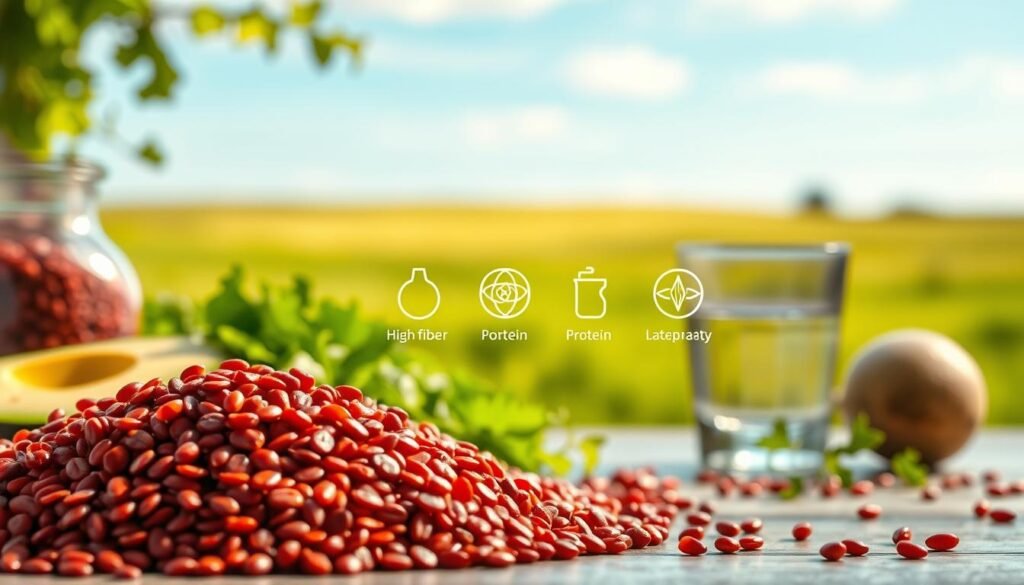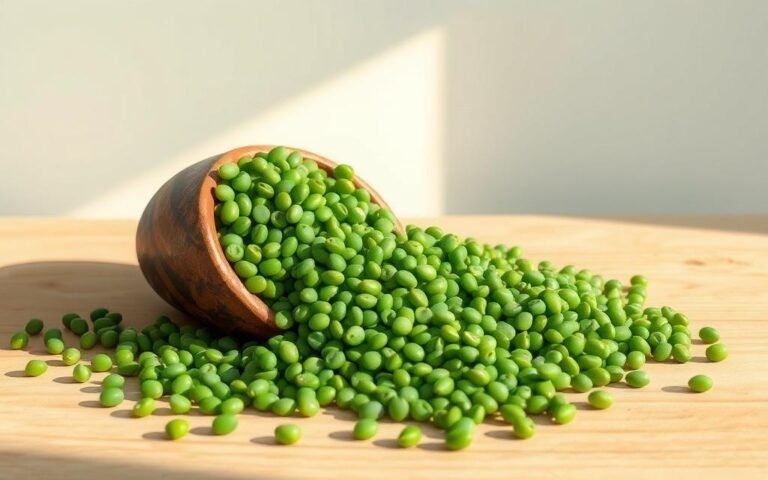Incorporating red lentils into your diet can have a significant impact on your overall health and wellbeing. Rich in fibre and iron, red lentils can help you feel full and energized throughout the day.
Not only are they nutritious, but they’re also good for the planet. Lentils require minimal water to grow and have a lower environmental impact compared to meat production. By adding red lentils to your weekly diet, you’re making a sustainable choice that supports a plant-based diet.
Key Takeaways
- Red lentils are rich in fibre and iron, supporting healthy digestion and energy levels.
- They are a sustainable food choice, requiring minimal water and having a lower environmental impact.
- Incorporating red lentils into your diet can support a plant-based lifestyle.
- Red lentils are versatile and can be used in a variety of dishes, from soups to curries.
- They are a good source of essential vitamins and minerals, including iron and potassium.
What Are Red Lentils? A Nutritional Powerhouse Explained
Red lentils, a type of legume, are gaining recognition for their versatility and health benefits. They are part of the Fabaceae family, which includes other nutritious foods like beans, soybeans, peanuts, and chickpeas. Lentils come in various colors, including brown, red, yellow, green, orange, and black, each with slightly different characteristics.
Origin and Varieties of Red Lentils
Red lentils are primarily grown in regions with temperate climates. They are a significant crop in countries like Canada, Australia, and parts of Asia. The red variety is particularly popular due to its quick cooking time and mild flavor. There are several varieties of red lentils, with some being more common in certain regions than others.
How Red Lentils Differ from Other Lentil Types
Red lentils differ from other lentil types mainly in their color and cooking time. They cook faster than green or brown lentils and have a softer texture when cooked. This makes them ideal for soups, stews, and curries. Nutritionally, they are similar to other lentils, providing a rich source of protein, fiber, and essential minerals.
Nutritional Profile of Red Lentils
Red lentils stand out for their exceptional nutritional profile, which includes a significant amount of protein, fibre, and various vitamins and minerals. They are a versatile and nutritious addition to a healthy diet.
Macronutrient Breakdown
Red lentils are rich in macronutrients that are essential for overall health. One cup of cooked lentils contains 18 grams of protein, 40 grams of carbohydrates, and 16 grams of fibre.
Protein Content
The protein content in red lentils is particularly noteworthy, making them an excellent option for vegetarians and vegans. With 18 grams of protein per cup, they contribute significantly to daily protein needs.
Carbohydrates and Fibre
Red lentils are also a good source of complex carbohydrates and dietary fibre. The fibre content helps in digestion and satiety, making them a filling and nutritious choice.
Essential Vitamins and Minerals
In addition to their macronutrient profile, red lentils are a rich source of essential vitamins and minerals. They are particularly high in iron, providing approximately 37% of the Daily Value per cup. Other key nutrients include folate, potassium, and manganese.
Antioxidant Properties
Red lentils also possess antioxidant properties that help protect against oxidative stress and inflammation. These antioxidants contribute to overall health and may reduce the risk of chronic diseases.
In summary, the nutritional profile of red lentils is impressive, with high levels of protein, fibre, and essential vitamins and minerals, along with significant antioxidant properties.
Benefits of Red Lentils for Overall Health
Red lentils are a nutritional powerhouse that offers a range of health benefits, from improving heart health to supporting immune function. Incorporating them into your diet can lead to significant overall health improvements.

Heart Health Advantages
The polyphenols present in red lentils have been shown to help reduce blood pressure and cholesterol levels, contributing to a healthier cardiovascular system. Regular consumption of red lentils can lead to improved heart health, reducing the risk of cardiovascular diseases.
Blood Sugar Regulation
Red lentils are beneficial for regulating blood sugar levels due to their low glycemic index and high fiber content. This makes them an excellent food choice for individuals managing diabetes or those looking to maintain stable blood sugar levels.
“The soluble fiber in lentils helps to slow down the absorption of sugar into the bloodstream, thereby regulating blood sugar levels.”
Immune System Support
Red lentils are rich in essential nutrients like zinc, iron, and vitamin B6, which play a crucial role in supporting immune function. A diet rich in these nutrients can help boost the immune system, making it more effective at fighting off infections.
In conclusion, the benefits of red lentils for overall health are multifaceted, ranging from heart health advantages and blood sugar regulation to immune system support. Incorporating red lentils into your diet can be a simple yet effective way to enhance your overall wellbeing.
Red Lentils as a High-Quality Plant Protein Source
In the realm of plant-based proteins, red lentils stand out for their impressive protein content and versatility in cooking. They are an excellent option for individuals looking to incorporate more protein into their diet without consuming meat.
Protein Content Compared to Other Plant Foods
Red lentils are particularly noteworthy for their high protein content. With approximately 9 grams of protein per 100 grams, they compare favorably to other plant-based protein sources. For example, chickpeas contain about 8.9 grams of protein per 100 grams, while almonds have around 6.3 grams per 100 grams, making red lentils one of the more protein-rich options.
| Food Item | Protein Content (g/100g) |
|---|---|
| Red Lentils | 9 |
| Chickpeas | 8.9 |
| Almonds | 6.3 |
| Quinoa | 4.4 |
Amino Acid Profile
Red lentils also boast a well-rounded amino acid profile, making them a valuable component of a plant-based diet. They are particularly rich in lysine, an essential amino acid that is often lacking in many plant-based foods. This makes red lentils an excellent complement to other plant proteins that may be low in lysine.
Benefits for Vegetarians and Vegans in Australia
For vegetarians and vegans in Australia, red lentils offer a convenient and nutritious way to meet daily protein needs. They can be easily incorporated into a variety of dishes, from soups and stews to curries and salads. With their high protein and fiber content, red lentils support overall health and well-being, making them a great addition to a balanced diet.
Weight Management and Red Lentils
Red lentils have been shown to support weight management through their unique combination of fiber and protein. This nutrient-rich food is not only filling but also helps regulate various physiological processes that contribute to maintaining a healthy weight.
How Red Lentils Support Healthy Weight
The high fiber and protein content in red lentils play a crucial role in supporting healthy weight management. Fiber helps slow down digestion, reducing the spike in blood sugar levels after a meal, while protein takes more energy to digest, thereby increasing metabolism. Together, they help create a feeling of fullness that lasts longer.
- Fiber slows down digestion, regulating blood sugar levels.
- Protein increases satiety and boosts metabolism.
- Red lentils are low in fat, making them a nutritious choice.
Satiety and Appetite Control
The satiety effect of red lentils is largely attributed to their fiber and protein content. By promoting feelings of fullness, red lentils help reduce overall calorie intake, making it easier to manage weight. Additionally, the complex carbohydrates in lentils are digested slowly, providing a sustained release of energy and further aiding in appetite control.
By incorporating red lentils into your meals, you can benefit from their nutritional profile that supports weight management and overall health.
Red Lentils for Gut Health and Digestive Wellness
Red lentils are emerging as a key ingredient in supporting gut health and overall digestive wellness. Rich in dietary fiber, they play a crucial role in maintaining a healthy digestive system.
Prebiotic Properties
Red lentils are an excellent source of prebiotic fiber, which feeds the good bacteria in the gut, promoting a balanced gut microbiome. This prebiotic property helps in enhancing digestive health and boosting the immune system.
Impact on Gut Microbiome
The fiber in red lentils has a profound impact on the gut microbiome. It supports the growth of beneficial bacteria and reduces inflammation.
Beneficial Bacteria Growth
The prebiotic fiber in red lentils encourages the growth of beneficial bacteria, which is essential for a healthy gut. This can lead to improved digestion and a stronger immune system.
Reduced Inflammation
By promoting a balanced gut microbiome, red lentils help in reducing inflammation in the gut, which can alleviate symptoms of various digestive disorders.
Incorporating red lentils into your diet can be a simple yet effective way to support your gut health. With their rich nutritional profile and prebiotic properties, they are an excellent addition to a healthy diet.

Incorporating Red Lentils into an Australian Diet
For Australians looking to enhance their diet with nutritious ingredients, red lentils are an excellent choice. They offer a rich source of protein, fiber, and essential minerals, making them a valuable addition to a variety of dishes.
Availability and Cost in Australian Markets
Red lentils are widely available in most Australian supermarkets, health food stores, and online retailers. They are relatively affordable, with a kilogram costing between $2 to $4, making them an economical option for families and individuals alike.
| Store | Price per Kilogram |
|---|---|
| Woolworths | $2.50 |
| Coles | $2.80 |
| Aldi | $2.20 |
Australian-Inspired Red Lentil Dishes
Red lentils can be incorporated into a variety of Australian-inspired dishes, such as lentil soups with bush tomatoes, red lentil curries with native spices, and salads featuring local vegetables. Their mild flavor makes them a versatile ingredient that can be adapted to many recipes.
Pairing with Local Australian Ingredients
Pairing red lentils with local Australian ingredients not only enhances the flavor but also supports local farmers and producers. Consider combining red lentils with ingredients like Tasmanian salmon, Victorian lamb, or fresh produce from the Adelaide Hills to create hearty and nutritious meals.
By incorporating red lentils into your diet, you can enjoy a range of health benefits while supporting the local economy.
Cooking with Red Lentils: Preparation Tips and Tricks
Learning how to cook red lentils properly can open up a world of culinary possibilities. Red lentils are a staple in many cuisines due to their ease of cooking and versatility in recipes. Whether you’re a seasoned chef or a beginner in the kitchen, understanding the basics of cooking red lentils can enhance your cooking skills.
Basic Cooking Methods
Cooking red lentils is relatively straightforward. They can be cooked in water or broth, making them a great addition to soups, stews, and curries. To cook red lentils, simply rinse them in cold water, then combine them with your chosen liquid in a pot. Bring to a boil, reduce the heat, and simmer for about 20-25 minutes, or until they’re tender. It’s essential to monitor the liquid level to prevent the lentils from becoming too dry.
Soaking: Necessary or Not?
One of the advantages of red lentils is that they do not require soaking before cooking, unlike some other types of lentils. This makes them a convenient option for meal preparation. However, rinsing them before cooking is recommended to remove any debris or impurities. Skipping this step can result in a less flavorful dish.
Common Cooking Mistakes to Avoid
To get the best out of your red lentils, avoid overcooking them, as this can make them mushy and unappetizing. Here are some common mistakes to avoid:
- Not rinsing the lentils before cooking
- Using too little liquid, causing the lentils to dry out
- Not seasoning the lentils during cooking, resulting in a bland flavor
By following these simple tips, you can enjoy perfectly cooked red lentils every time.
Versatile Red Lentil Recipes for Every Meal
With their high protein content and nutritional benefits, red lentils are an excellent choice for a variety of meals throughout the day. Whether you’re looking for a hearty breakfast, a quick lunch, or a satisfying dinner, red lentils can be incorporated into your meal planning in numerous delicious ways.
Breakfast Ideas with Red Lentils
Starting your day with red lentils can be both nourishing and delicious. Here are a couple of ideas:
Red Lentil Porridge
A warm and comforting bowl of red lentil porridge is a great way to begin the day. Simply cook the lentils with your choice of milk, add some spices, and top with fresh fruits or nuts.
Breakfast Patties
Red lentil breakfast patties are a protein-packed option that can be made in advance. Mix cooked lentils with vegetables and spices, shape into patties, and cook until golden brown.
Lunch and Dinner Recipes
Red lentils are incredibly versatile for lunch and dinner dishes. They can be used in soups, stews, curries, and salads, adding a boost of protein and fiber. Some popular ideas include:
- Red lentil soup with a swirl of cream
- Lentil and vegetable curry served with rice or naan
- A hearty lentil stew with crusty bread
Snacks and Sides
Red lentils aren’t just for main meals; they can also be used to make tasty snacks and sides. Consider making:
- Red lentil hummus for a protein-rich dip
- Lentil and herb fritters as a crispy snack
- A side of sautéed lentils with garlic and spinach
These are just a few examples of the many ways you can incorporate red lentils into your diet. Experimenting with different recipes and flavors can help you find your new favorite dishes.
Sustainability and Environmental Benefits of Red Lentils
As the world shifts towards more sustainable food options, red lentils stand out as a promising choice. Their cultivation is associated with several environmental benefits that make them an attractive crop for farmers and consumers alike.
Water and Land Use Efficiency
Red lentils are a drought-tolerant crop that can thrive with minimal rainfall, requiring as little as 10 inches of annual rainfall. This characteristic makes them highly water-efficient, especially when compared to other protein-rich foods. Additionally, lentils can be grown in rotation with other crops, improving soil health and reducing the need for fertilizers.
Carbon Footprint Compared to Animal Proteins
The production of red lentils generates significantly lower greenhouse gas emissions compared to animal-based protein sources. This is because lentils are a plant-based protein that doesn’t require the resource-intensive processes associated with livestock farming. By choosing red lentils, consumers can reduce their dietary carbon footprint.
Supporting Sustainable Agriculture in Australia
In Australia, the cultivation of red lentils supports sustainable agriculture by promoting rotational farming practices and enhancing soil biodiversity. This not only benefits the environment but also contributes to the long-term viability of farming operations.
Potential Considerations and Side Effects
While red lentils are generally considered safe to eat, there are some potential considerations to be aware of. Red lentils, like other legumes, contain certain compounds that may affect some individuals more than others.
Antinutrients in Red Lentils
Red lentils contain antinutrients like phytic acid, lectins, and saponins. These compounds can interfere with the absorption of certain nutrients. However, it’s worth noting that proper preparation methods such as soaking, boiling, or sprouting can significantly reduce the levels of these antinutrients, making the lentils more nutritious and easier to digest.
Who Should Exercise Caution
Individuals with certain health conditions or those who are prone to specific dietary issues should be cautious when consuming red lentils. For instance, people with digestive issues may need to be mindful of their lentil intake. It’s always a good idea to consult with a healthcare professional or a registered dietitian for personalized advice.
Allergies and Intolerances
Although rare, some people may be allergic or intolerant to lentils. Symptoms can range from mild discomfort to severe reactions. If you experience any adverse effects after consuming red lentils, it’s essential to seek medical attention. For more information on lentil nutrition and potential side effects, you can visit Organic Gyaan.
Conclusion: Making Red Lentils a Regular Part of Your Diet
Red lentils offer a multitude of benefits that make them an excellent addition to a healthy diet. From their high nutritional value to their versatility in cooking, incorporating red lentils into your weekly meal plan can have a significant impact on overall health and wellbeing.
By including red lentils in your diet, you can support heart health, regulate blood sugar levels, and promote digestive wellness. Their high protein content and prebiotic properties make them particularly beneficial for vegetarians and vegans, as well as those looking to manage their weight.
With their ease of preparation and adaptability in various recipes, making red lentils a regular part of your diet is both simple and rewarding. Start exploring the world of red lentils today and discover the positive difference they can make to your health and culinary experiences.





